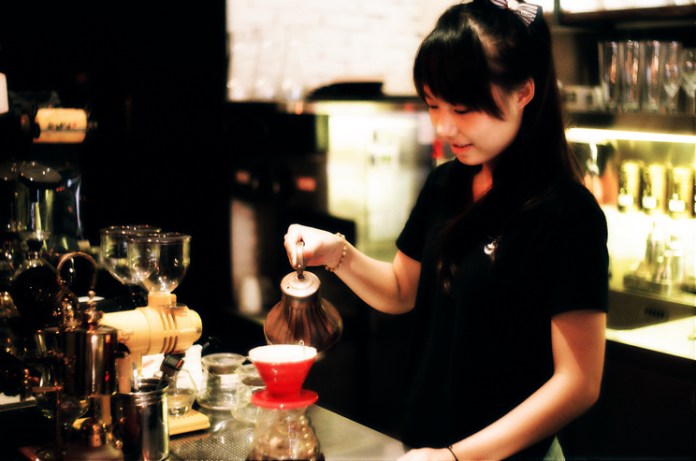Tear off son workbook when filter paper, a housewife changes hand brewed coffee history

For professional baristas, please follow the coffee workshop (Wechat official account cafe_style)
With the sweeping of the third wave of coffee, boutique coffee has become the mainstream of the global coffee industry, and nothing shines more brightly than hand-brewed coffee. In addition to the emergence of a large number of coffee shops specializing in hand-brewing coffee, hand-brewing is very sensitive to personal feelings, so it has also blown a wave of personalization, and even in social media, the community that belongs to hand-brewing has gradually taken shape.
So, you who love hand flushing, do you know the history of hand flushing?
Because the source of this wave of boutique coffee can be said to be Japan, many people mistakenly think that hand-brewed coffee was invented in Japan. In fact, the modern method of making hand flushing comes from an unexpected country-Germany. The inventor is a legendary woman in the European coffee industry, from an ordinary housewife to the chairman of a company.
Since coffee was introduced into Europe from Arabia, the traditional way of making coffee in Europe is to use linen or metal strainer to filter out the coffee grounds. However, if you use linen cloth, wash it very clean every time you use it, otherwise it will stink. If the use of metal filter, it is limited to the level of technology at that time, can not make enough small pores, so it will let a lot of coffee grounds through the filter.
The modern common technology of using filter paper to filter coffee powder was invented by Melitta Bentz, a German housewife, in 1908 and has been in use ever since.
A portrait of Mrs. Merita
Mrs. Merita, 35, who was quite young at the time, loved coffee very much, but she thought the traditional way of making coffee was very troublesome, so she always hoped to invent a more convenient and easy way to make coffee. When she was worried about this, she happened to see her son's school workbook. In a flash of inspiration, she used the ink paper of the workbook to make the world's first coffee filter paper.
Fan-shaped filter paper
The texture of the filter paper made of ink paper is quite light and thin, and compared with linen, it is cheap, discarded after use, and has less trouble of cleaning. The function of the filter residue is even more excellent. Compared with the metal filter, after the coffee grounds are brewed with less coffee grounds, not only the strange taste of the coffee grounds in the mouth disappears, but also the bitterness and astringency are reduced, and the coffee produced is more palatable than ever. In addition, Mrs. Melita also created a hand-punched ceramic filter cup.
I don't want the epitaph to just say "Housewife."
Melita's friends were shocked by the wonderful taste of her hand-brewed coffee, and some suggested that she should start her own business and sell filter paper and cups. The proposal was very attractive to Mrs. Merita, but it was also difficult to choose because it was very special in Germany at the time, and the traditional view was that a housewife should take good care of the house rather than start a company.
Mrs. Merita has the characteristics of a typical German woman-resolute, independent and strong. As a young woman, she doesn't want the words "housewife" written on her tomb inscription after death. She doesn't want her life to be like this ordinary past. As a result, Mrs. The Melitta Company patented her filter paper and cup in 1908 and founded Merita in the same year.
The trademark of Melita Company
Surprisingly, in the face of public disbelief and accident, Mrs. Melita actually excelled in the management of the company, not only expanding a large customer base through word-of-mouth marketing, but also constantly bringing forth new ideas in hand-brewing coffee appliances, launching a series of new products in 1920 and 1930s.
As the products launched by the company sell well all over Europe, the handmade coffee invented by Mrs. Merita is also popular all over the world. This has further established Mrs. Merita's status as a "godmother" in the hand coffee industry, and must have envied many people for her successful experience of starting a business for the first time.
The Melitta Company ran the company as a family business and served as chairman of the company until her death in 1950, and as hand fans know, Melita is still the leading brand in the European hand punch industry.
Slow down and enjoy the self-exploration of brewing
However, with the gradual popularity of Italian coffee machines and the rise of Starbucks, which represents coffee commercialization and American fast culture in the 1980s and 1990s, hand-brewed coffee, which emphasizes "slow", has gradually declined in Europe and the United States. Until the past 10 years, with the third wave of coffee, hand-brewed coffee has sprung up again in Japan.
Today's hand-brewed coffee can be said to be combined with the Japanese "Zen way" and "tea ceremony", emphasizing self-exploration and enjoyment in the brewing process, and carried forward by teacher Taguchi, and then gradually introduced into Taiwan.
In fact, in the past few years, there has been a gradual revival of hand-brewed coffee in Europe and the United States. Coffee originated in Ethiopia and was introduced into Europe through Arab merchants until modern times, the Italian invented the Italian coffee machine, the Americans used Starbucks to conquer the world, and the hand brewing was invented by Germany, but gradually declined. now, combined with the traditional culture of Asia, it has been transmitted back to Europe and the United States from Japan.
Coffee has always been the crystallization of the fusion and conflict between the East and the West.
Important Notice :
前街咖啡 FrontStreet Coffee has moved to new addredd:
FrontStreet Coffee Address: 315,Donghua East Road,GuangZhou
Tel:020 38364473
- Prev

The first wave of coffee history: how to make office workers have a drink with you no matter how busy they are?
Professional barista communication Please follow the coffee workshop (Wechat official account cafe_style) you who love coffee must have heard of the so-called coffee tide. In fact, in the process of coffee evolution, there are three different waves of coffee sweeping the world, and the coffee market you see now is intertwined by these three waves of coffee. Today, these three different waves of coffee
- Next

Look at the outside world and don't just wait for one person in your coffee shop.
Communication of professional baristas Please pay attention to the coffee workshop (official Wechat account cafe_style) with bright lights and simple lines. Looking into the window, there are huge bean dryers and computer detection instruments. Were it not for the smell of coffee, it would be a science laboratory. Our meeting with Mr. Hu Yuanzheng was chosen at this Taoxuan coffee experience shop located in the Neihu Science and Technology Park.
Related
- Why are the coffee in some coffee shops not enough after being frozen? What should I make up for my American latte cappuccino coffee after being frozen?
- How much water does it take to steam coffee by hand? Why is the coffee brewing and steaming time 30 seconds? What is the purpose of steaming coffee?
- The suspected drink contains too much caffeine! Overlord Tea Lady responds urgently!
- Starbucks rejects antique paper coupons?! Netizen: Missed marketing opportunities!
- What ratio of water temperature and ground does the smart cup method use to press coffee? The difference between brewed coffee and filtered coffee?
- What is the standard process for the purpose of coffee cup testing? What is the difference between hand-brewed coffee and cup testing?
- How to use hand-brewed coffee paragon small golden balls? How does cold coffee lock in the aroma of coffee?
- Is American coffee black? What is the difference between American coffee and drip coffee?
- Unexpected! Well-known tea beverage brand Lele Tea will withdraw from the Zhengzhou market!
- Starbucks enters the fashion and beauty industry?! Netizen: Give me an ice American eye cream

